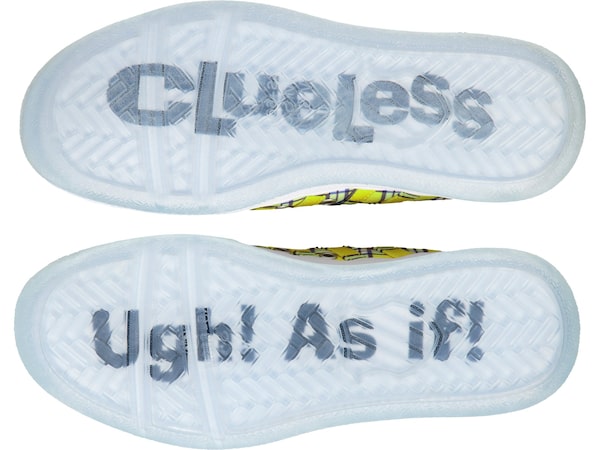
People are more frequently putting their nostalgia of childhood on display with clothing and merchandise purchases.Supplied
Last winter, in a moment of fatigue and January-induced sorrow, I dragged my friend to Urban Outfitters, rifled through their sweatshirts and settled on one that was as understandable as it was puzzling: a grey pullover adorned with the word Friends, as in the TV series.
I like, but am not delusional about the popular show. I grew up with it, quoted it to excess, but have also come to realize in the 25 years since its debut that its issues are glaring: It’s often homophobic, transphobic and entire seasons revolved primarily around white, affluent people. That said, in moments of sadness or darkness we tend to cling to what’s comforting, familiar, or reminds you of being a little kid, watching reruns at your best friend’s house. Before this shopping trip, I’d begun a marathon viewing of the show through a difficult Christmas, New Year and aftermath, in order to stay buoyant. Thanks to Urban Outfitters, I soon wore my allegiance on my sleeve. Or, more specifically, across my chest.
This isn’t the first time I’ve purchased an item such as this. As nostalgia has become an increasingly mainstream cultural currency, I’ve proudly bought and worn H&M tops branded with the Titanic and Romeo + Juliet film posters, obsessively quested for K-Swiss’s recent Clueless tie-in sneakers (to no avail), and am, as I write this, wearing a Uniqlo T-shirt with a skateboarding Charlie Brown on the pocket. At 34, I have become the real-life version of Michael Scott from The Office holding up complimentary tote bags at a paper conference yelling, “SWAG!” And perhaps more shamefully, I’ve even bought the Dunder Mifflin computer paper to further pledge my allegiance to the pillars of pop culture that have come to define me.
Thankfully, I’m not alone. Official and knock-off merch has long kept cultural institutions afloat. Members of fandoms across film, TV and everything else have consistently used their wardrobes as a means of declaring where their loyalties lie. But in 2019, it’s become less a question of draping one’s self in Harry Potter scarves, Doctor Who hoodies, or even investing in Taylor Swift’s collaboration with Stella McCartney (which, for the record, reads like standard concert merch, which is disappointing if you were hoping for pieces that actually look like something you’d see in a Stella McCartney collection. But I digress). Now, brands are stepping up to make flying one’s (pop culture) freak flag seem intentional, chic even. Which, as someone who owns a Friends sweatshirt, can be difficult. I mean, is an outward obsession ever cool?
Brands are stepping up to make flying one’s (pop culture) freak flag seem intentional, chic even.Chris Helgren/Reuters
Well, no. But that’s arguably the point of fandom to begin with. To be a fan is to have zero chill; it’s to be so excited about something all the time that you’re willing to scream your devotion from within an audience of hundreds, thousands or even millions. It’s powerful and incredible, but it can’t be sustained if you’re also aiming for the apathy that comes with being cool. You also can’t be earnest and simultaneously as hip as the characters you love. Cher Horowitz would never wear Clueless-branded K-Swiss sneakers, regardless of how well they work with her iconic plaid ensemble. The Doctor isn’t out there in her TARDIS wearing a Doctor Who-branded hat. SpongeBob SquarePants isn’t being drawn lacing up a pair of Kyrie Irving’s SpongeBob shoes. Ultimately, the mere act of buying and wearing a piece tied into pop culture separates the wearer from the universe they’re obsessed with. Instead, we’re exclaiming our enthusiasm for the world the characters live in.
But we’re also pining for the world we lived in when these characters first won our hearts. As we’ve learned from the return of mom jeans, Sketcher slides, mini backpacks and the wall of Tamagotchis I spotted at that same Urban Outfitters, nostalgia isn’t a trend, it’s a key component of our cyclical culture. We celebrate, analyze and repackage the past and have been doing so for decades and now millennials get to reap the benefits of what seems old or vintage to those younger than we are. They get to assign meaning to the best parts of our past and we get an excuse to delve back and exist in our highlight reels, sometimes finding meaning in what once made us happy.

As we’ve learned from the return of mom jeans, Sketcher slides, mini backpacks and the wall of Tamagotchis I spotted at that same Urban Outfitters, nostalgia isn’t a trend, it’s a key component of our cyclical culture.NIKE/Nike
This isn’t to say every tie-in is a game-changer. Pottery Barn’s Friends capsule collection is plucked right out of the episode in which, well, Phoebe learns about Pottery Barn, which means that it can arguably be recreated by going to any furniture store and finding pieces that look reasonably nineties. So: every furniture store. TOMS’ Star Wars line looks similar to Star Wars collections by Vans or Converse. And this Uniqlo Peanuts T-shirt? I’ve parlayed it into pyjama wear. But I still don’t think the merch 2.0 bubble is close to bursting.
Unlike Friends itself, which will fade from Netflix next year, the fascination with and romanticization of the comforts of our past will only increase the further we move away from it. The older things get, the more iconic they tend to become. And while H&M and Urban Outfitters’ answer to nostalgia is obviously unoriginal by playing on what we’ve seen of merch for years, it’s still a mainline to earnestness and a quick way to declare to which fandom you belong. Or maybe most importantly, a means to feeling a little less alone.
Visit tgam.ca/newsletters to sign up for the weekly Style newsletter, your guide to fashion, design, entertaining, shopping and living well. And follow us on Instagram @globestyle.